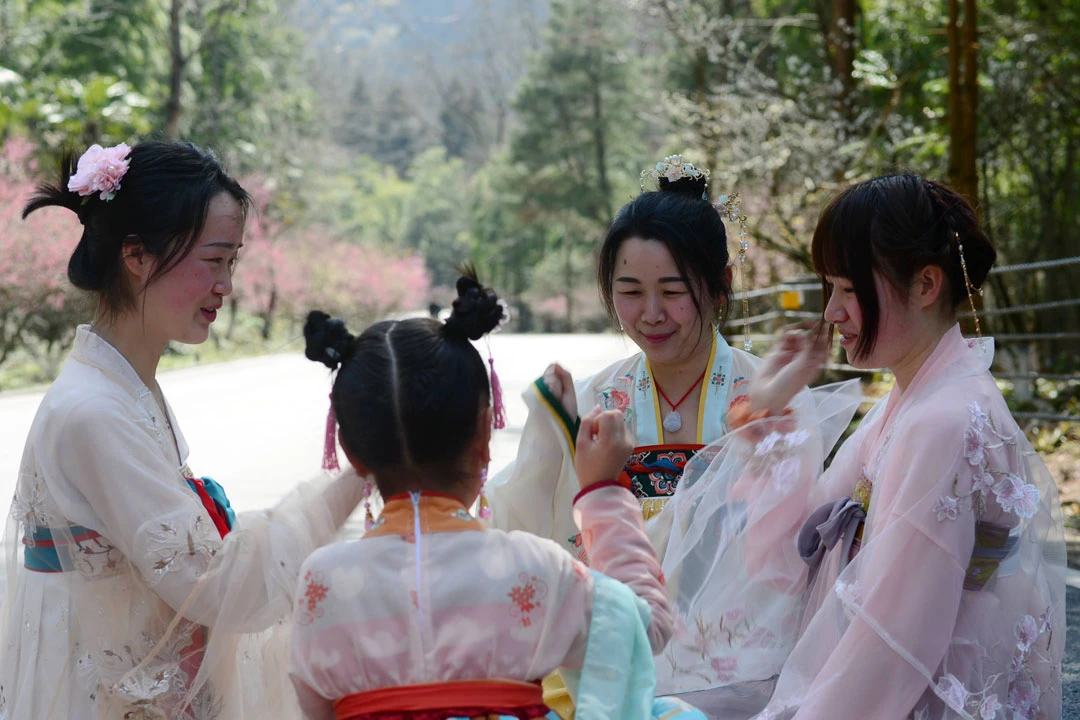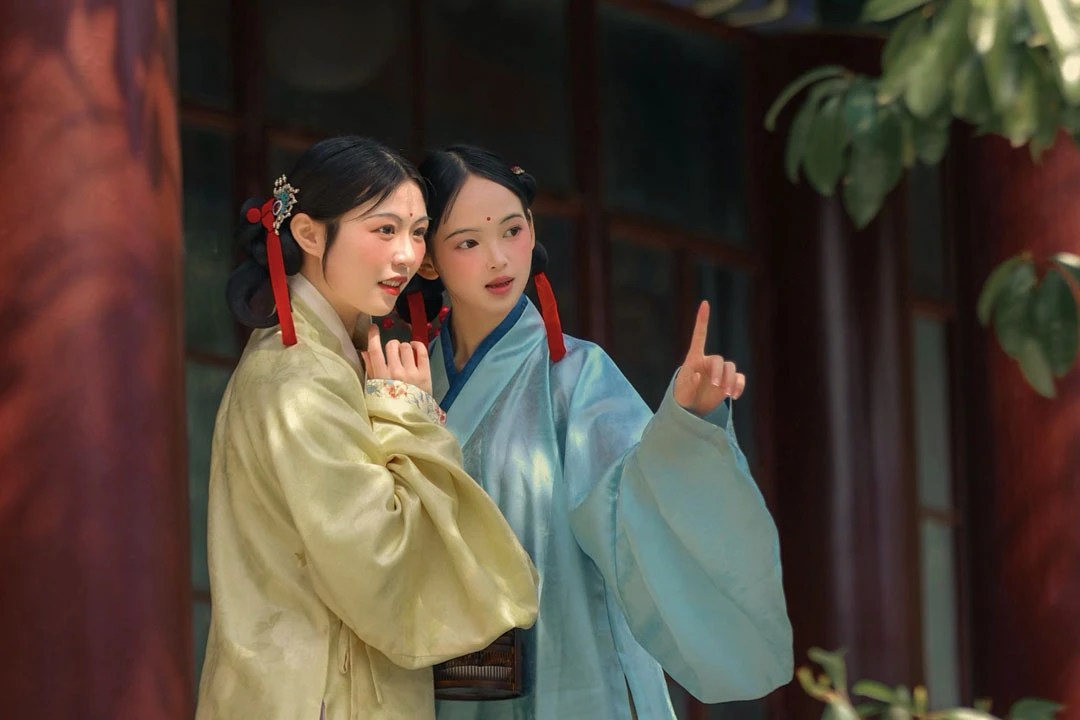In the heart of China's breathtaking Zhangjiajie (张家界)0 Grand Canyon, an extraordinary fusion of ancient tradition and modern tourism is unfolding. As the Qixi Festival, often referred to as Chinese Valentine's Day, approaches, the iconic glass bridge spanning the canyon has transformed into a vibrant stage for cultural celebration and international exchange.

Glass Bridge Becomes Stage for Ancient Love Story
On August 10th, visitors to the Zhangjiajie Grand Canyon were treated to an unexpected spectacle. The usually transparent glass bridge, known for offering heart-stopping views of the canyon below, was adorned with traditional Chinese architectural elements. Red walls, green-tiled roofs, and a delicate "magpie bridge" spanning its length created a surreal blend of modern engineering and ancient aesthetics.
As music filled the air, dancers dressed as the legendary characters Niulang (牛郎) and Zhinü (织女) (the Cowherd and Weaver Girl) took center stage. Their performance, a mesmerizing blend of traditional and contemporary dance, brought to life the poignant tale of star-crossed lovers reunited for a single day each year.
George, an American tourist who had come to experience the glass bridge's famous views, found himself captivated by the performance. "The dancers' movements were so graceful," he remarked. "In their expressions, I could almost see the joy and longing of Niulang and Zhinü meeting again after a year apart."
The event, titled "Hand in Hand Across the Clouds, Traversing Love Together," wasn't just a performance. It was a carefully crafted immersive experience designed to introduce foreign visitors to the rich tapestry of Chinese culture through the lens of the Qixi Festival.
Foreign Tourists Embrace Chinese Heritage Through Hanfu
Perhaps the most striking aspect of the celebration was the sight of international visitors donning elaborate Hanfu, traditional Chinese clothing. From the delicate and understated to the opulent and ornate, these garments served as a tangible connection to thousands of years of Chinese history.
Autumn, a visitor from Belarus, couldn't contain her excitement as she twirled in her flowing Hanfu robes. "I've always admired Chinese traditional clothing in movies," she shared, "but actually wearing it and participating in these customs makes me feel like I'm truly experiencing a piece of Chinese culture."
The event organizers took care to introduce visitors to various Qixi customs. Tourists tried their hand at traditional activities such as threading needles for good fortune and tossing needles into a bowl to test their luck in love. These simple games, steeped in centuries of tradition, provided a hands-on way for visitors to engage with Chinese cultural practices.
Alex, a tourist from Turkey, found himself particularly moved by the experience. "Hanfu embodies classical beauty, subtlety, and grace," he observed. "It carries within its folds the story of a civilization's development over thousands of years. I have a deep respect and admiration for it."
Cultural Exchange Flourishes in Zhangjiajie's Scenic Wonder
The Qixi celebration at Zhangjiajie Grand Canyon is more than just a tourist attraction; it's a deliberate effort to promote cultural exchange and understanding. Zhang Jiqian, the general manager of the scenic area, explained the motivation behind the event: "With the implementation of the 144-hour visa-free transit policy, we've seen a significant increase in international visitors. We saw this as an opportunity to promote Chinese culture, share our stories, and let the world experience the beauty of Chinese traditions and civilization."
This approach seems to be paying off. The Zhangjiajie Grand Canyon scenic area has welcomed nearly 450,000 international visitors this year, a substantial increase from previous years. These numbers reflect not just the area's natural beauty but also a growing global interest in experiencing authentic Chinese culture.
The success of this event highlights a broader trend in cultural tourism. As travelers seek more meaningful and immersive experiences, destinations that can offer a blend of natural beauty and cultural richness are uniquely positioned to thrive.
Moreover, events like this serve an important diplomatic function. By inviting foreign visitors to not just observe but participate in traditional customs, China is fostering a deeper, more personal connection between cultures. Each tourist who dons a Hanfu or attempts to toss a needle into a bowl becomes, in a small way, an ambassador for Chinese culture when they return home.
The Qixi celebration at Zhangjiajie also demonstrates how traditional festivals can be reimagined for the modern era without losing their essential character. By setting ancient customs against the backdrop of a marvel of modern engineering - the glass bridge - the organizers have created a powerful visual metaphor for China itself: a nation with deep roots in history that is simultaneously at the forefront of technological innovation.
As the sun set on the glass bridge, casting long shadows across the canyon, the day's events took on an almost magical quality. Foreign tourists, still clad in their Hanfu, mingled with local visitors, sharing stories and snapping photos. The ancient tale of Niulang and Zhinü, of love overcoming great obstacles, seemed to resonate across cultures and languages.
In this moment, on a bridge suspended between earth and sky, the past and present seemed to merge. The Qixi Festival, with its rich traditions and poignant mythology, had been brought to life in a way that was both authentic and accessible to a global audience.
As visitors departed, many expressed a desire to learn more about Chinese culture and to return for future festivals. This, perhaps, is the true measure of the event's success - not just in providing a day of entertainment, but in planting seeds of cultural curiosity and understanding that will continue to grow long after the tourists have returned home.
In an increasingly interconnected world, events like the Qixi celebration at Zhangjiajie serve as important reminders of the power of cultural exchange. They demonstrate that even as we embrace modernity and technological advancement, there is still immense value in preserving and sharing our unique cultural heritage. Through these shared experiences, we build bridges of understanding that span not just canyons, but the divides between nations and cultures.


